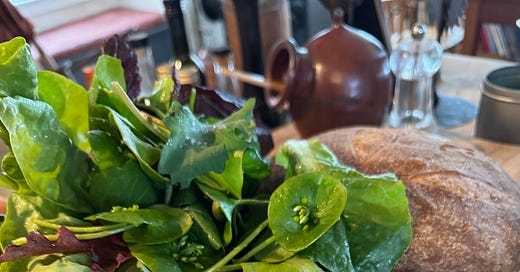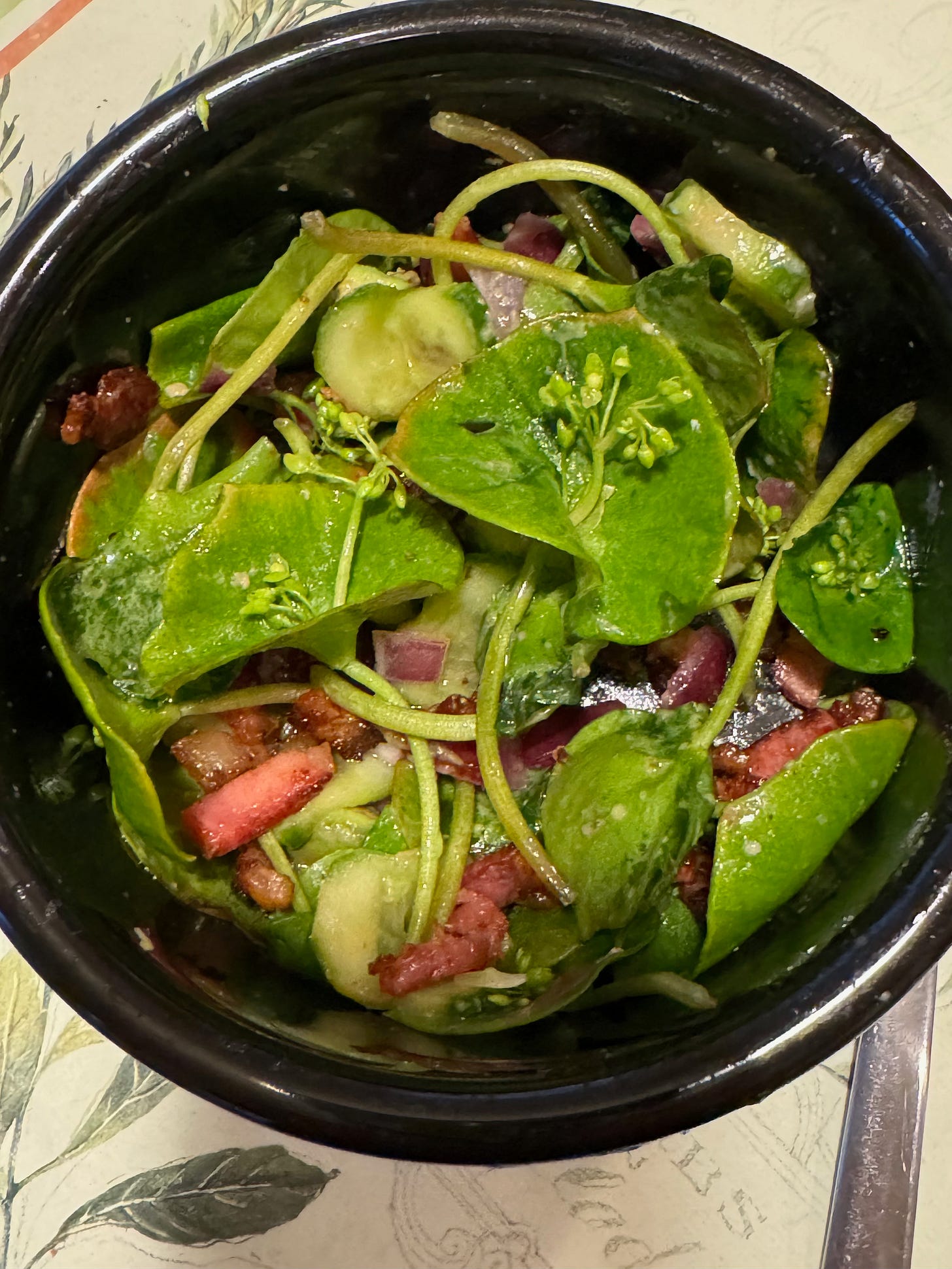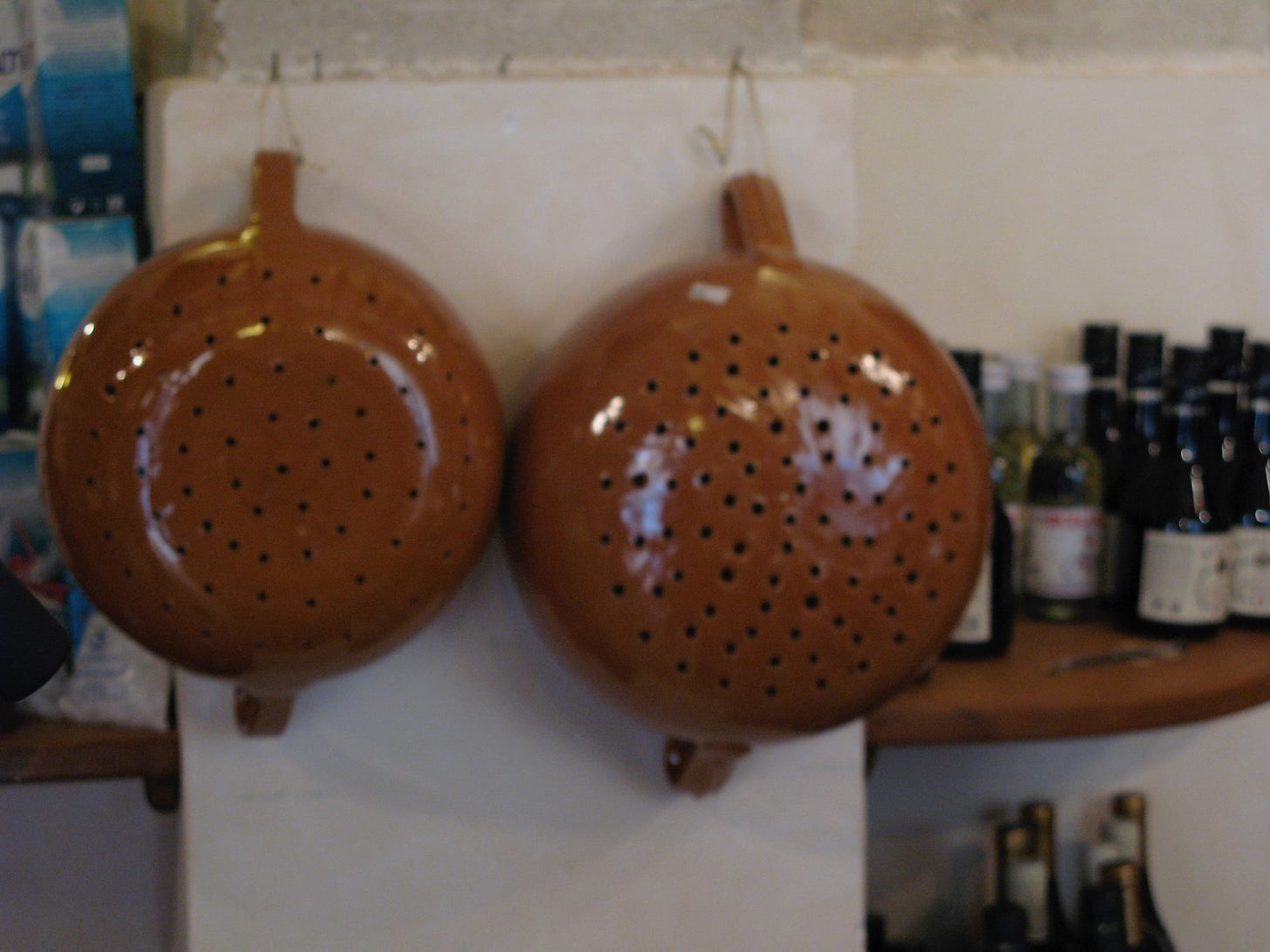Just hit that little heart button up above the spring vegetables, please—it means a lot! And then send me a comment and let me hear what you think.
Go on outside!
It’s that time of year again when the heart yearns to be outside, out where buds are swelling on the apple trees, rhubarb and daffodils are pushing up through the muddy ground, streams are flowing, spring peepers are chirping away at the water’s edge, and the early morning clamor of nesting birds is enough to wake the dead. On the kitchen porch we’ve already enjoyed a few moments of calm before the storm of summer with its endless stretch of visitors and its endless lines of traffic blocking Main Street.
Farmers’ markets and farm stands are opening one after the other, and I find myself introduced to new vegetables that delight me: two in particular that aren’t exactly new but they’re welcome as old friends, sometimes put to new uses.
Example #1: Hakurei turnips, small and beautiful, like round balls of alabaster, they’re great used raw, like radishes, in a salad, or braised briefly in a skillet with olive oil and a touch of garlic. The greens are as valuable as the turnips themselves and should be rinsed and steamed, then tossed in a skillet with oil and garlic and served, maybe with those braised turnips added to the pot.
Example #2: Claytonia, aka Miner’s Lettuce
Claytonia perfoliata, sometimes called winter purslane, is an odd little salad green that apparently grows wild in parts of the Rocky Mountain West. Here in the east it’s a garden favorite for late winter to early spring because it’s resistant to cold. Those fleshy pads you see in the photo are just a touch succulent and they give a delightful texture to a salad. This one got mixed with cucumber, avocado, and some sizzled lardons of thick smoked bacon. And then the usual garlic-salt-olive-oil-lemon-juice dressing. A welcome green at any time, but especially when there’s nothing else available. And a tribute to Emily Nunn whose Department of Salad helped me get started on this Substack journey.
Haschich Fudge, aka Cannabis Cookies
Ruth Reichl wrote recently about a favorite cookbook that also holds an honored place on my kitchen bookshelf, alongside Elizabeth David’s French Provincial Cooking, Marcella Hazan’s Classic Italian Cookbook, Marjorie Mosser’s Good Maine Food, and Jean Anderson’s Doubleday Cookbook. An eclectic collection, these are all books I turn to for inspiration as much as for information. In the case of The Alice B. Toklas Cookbook, the information was critical at a certain point in my life.
I have actually had two copies of The ABTCB (an acronym so I don’t have to write out the whole long title every time I mention it). The first copy was purchased in New York long before I was married, long before I packed my bags and moved to London, and on to Paris, Madrid, and all the other places on a lifelong itinerary. What I remember best from that book was the instruction to marinate chunks of beef (upper shoulder was called for) in good brandy for six hours before preparing your boeuf bourguignon (which, interestingly, is included in a chapter called “Little-Known French Dishes”). I continue to do that on the rare occasions when I make boeuf bourguignon, today one of the best-known of all French dishes. And it makes a tasty difference.
I still have that copy of The ABTCB, but, having left it behind in America, I acquired in London another copy, this time the British edition. It was there that I came across a rumored recipe for hashish fudge, or, as it was spelled, Haschich Fudge, which was missing from the American edition. The recipe had very little to do with either fudge or hashish but that was unimportant. The story is that it had been deliberately left out of the American edition of The ABTCB by the editors at Harper & Brothers, with the understanding that hashish was a forbidden substance in the U.S.
This is the recipe and it was a revelation:
Haschich Fudge (which anyone could whip up on a rainy day)
This is the food of Paradise—of Baudelaire’s Artificial Paradises: it might provide an entertaining refreshment for a Ladies’ Bridge Club or a chapter meeting of the DAR. In Morocco it is thought to be good for warding off the common cold in damp winter weather and is, indeed, more effective if taken with large quantities of hot mint tea. Euphoria and brilliant storms of laughter; ecstatic reveries and extension of one’s personality on several simultaneous planes are to be complacently expected. Almost anything Saint Theresa did, you can do better if you can bear to be ravished by “un évanouissement reveillé.”
Take 1 teaspoon black peppercorns, 1 whole nutmeg, 4 average sticks of cinnamon, 1 teaspoon coriander. These should all be pulverised in a mortar. About a handful each of stoned dates, dried figs, shelled almonds and peanuts: chop these and mix them together. A bunch of cannabis sativa can be pulverised. This along with the spices should be dusted over the mixed fruit and nuts, kneaded together. About a cup of sugar dissolved in a big pat of butter. Rolled into a cake and cut into pieces or made into balls about the size of a walnut, it should be eaten with care. Two pieces are quite sufficient.
In Madrid, where I was living with my family (one child, another on the way) when the opportunity to make “haschich fudge” presented itself, most of those ingredients were easy enough to obtain. Only the hashish, forbidden by the Franco government, was a problem. And then one day a pair of hippies arrived on our doorstep in the little community called Fuente del Berro (Watercress Fountain) after a famous spring at the heart of the colony. They had just blown in from Morocco, having come across on the ferry to Algeciras and hitched their way to Madrid on the hippie trail, eventually heading to Kabul, Kathmandu, and ultimately, they said, to Bangkok. And they were carrying the dangerous and illicit substance. Not hashish, in fact, but marijuana, fragrant, sundried, crushed leaves of Cannabis, whether sativa or indica no one knew but it didn’t seem to matter. It was straight from a sunny Moroccan meadow and ready to be smoked. Or used in the kitchen.
So I set to work, pounding together handfuls of dried fruits and nuts. Curiously, peanuts were unobtainable but I added hazelnuts in their place, much nicer. And then I scattered a handful of crushed marijuana over the mix, kneaded it all together with the sugary butter, and rolled it into bite-sized pieces which I also dusted with powdered sugar just to keep them from sticking together. That night after putting the child to bed, the husband and I, together with the au pair (who, being from Aspen, knew about such things), sampled the truly delicious balls of crunchy, sticky sweetness. After one, we felt nothing, so we each had another. And after two, we still felt nothing, so we helped ourselves to a third. And then, feeling nothing giddy but replete with sweets, we said goodnight and went to bed.
Next morning, over coffee, I said sort of casually, “I had such weird dreams last night.” “Gosh!” said the au pair, just back from walking the child to school, “so did I.” And the husband, having appeared for the newspapers which he read diligently as part of his job, looked up: “I had incredible dreams,” he said, “could it have been the fudge?”
Which of course was not fudge at all. But, thanks to Alice B., it was memorable—and as it turned out, it wasn’t even her recipe but rather the contribution of a friend. There was no suggestion that she had ever prepared the confection or consumed it. So my vision of Alice and Gertrude Stein, her imperious companion, had to be adjusted: No longer could I envision the pair popping cannabis cookies in their greedy mouths and giggling all the way home from cocktails with Hemingway and Picasso and Braque, ravished by “un évanouissement reveillé.” But at least the recipe lives on, now apparently available to all comers in the most recent edition of The ABTCB, which comes with Ruth Reichl’s foreword and perhaps her blessing.
A DISSERTATION ON COUSCOUS
Terracotta coucous pots hanging in a Sicilian kitchen
Speaking of Morocco, I used to think of couscous as a strictly North African (Maghrebi) dish, an iconic pasta from the Berbers of Morocco, Algeria, and Tunisia. But I was wrong. Couscous is ubiquitous all over the Islamic Mediterranean, from Turkey to Lebanon and Palestine, and it stretches beyond too--to Sicily, Sardinia, Greece, and maybe elsewhere, even down into West Africa. (Couscous is a favorite dish in southern France and Israel too, but there it a recent addition to the table, either brought in by North African immigrants or adopted from the indigenous population, hence not truly a historic national tradition—although it may well become one.) The couscous made throughout this broad area varies from region to region, even from town to town, and it’s often quite different from the tiny, elegant grains produced by the most adept Moroccan cooks. Most often, like pasta, it’s made from hard durum wheat but sometimes barley or even millet is used. (Barley couscous, called belboula in Moroccan Arabic, is available from Kalustyan if you’d like to experiment with it.)
Larger grains of couscous are called m’hamsa in Tunisia. A favorite for those of us who dine on the kitchen porch is the m’hamsa made by Moulins Mahjoub (try their fine olive oil too), imported by the Rogers Collection, and available in many fine food stores. In Lebanon even larger grains, sometimes as big as chickpeas, are called maghrabiyeh, a name that comes from their perceived origin in the Maghreb. (That’s the Arabic name for Northwest Africa; it means “the west,” or more literally “where the sun sets.”) Maureen Abood makes a typical Lebanese chicken soup, also called maghrabiyeh, with couscous and chickpeas, the two almost matching each other in size. She cooks them in an aromatic broth flavored with cinnamon and Lebanese baharat, a blend of spices including allspice, cumin, coriander seeds, and cloves.
The remainder of this post is available only to paid subscribers. Please consider becoming a paid subscriber to see everything I’ve discovered about couscous.
Keep reading with a 7-day free trial
Subscribe to On the Kitchen Porch to keep reading this post and get 7 days of free access to the full post archives.








